Potatoes are a popular vegetable in the beds of modern vegetable growers. Russian gardeners are simply inventors in their field. Growing potatoes has become a real hobby for some. Conventional cultivation methods are no longer of interest to them. Consider how else you can grow potatoes, except in the furrows.
Material Content:
- 1 Methods of growing potatoes in the open field
- 2 Growing potatoes under the straw
- 3 The technology of growing potatoes in bags
- 4 How to grow potatoes in boxes
- 5 Growing potatoes from seeds
- 6 Chinese way
- 7 According to Dutch technology
- 8 Mitlider and Gulich Method
- 9 Technology "under the film"
- 10 How to grow potatoes in greenhouses
Methods of growing potatoes in the open field
Like any plant, potatoes can be grown by seed. This is a longer and troublesome method, but it takes its place in agricultural technology.
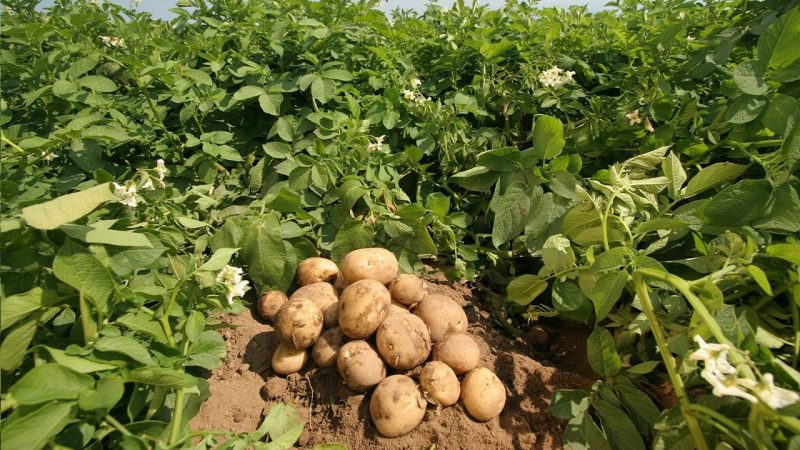
They do this under cover of straw. It protects the tubers from the cold and the sun, retains moisture. There is a technology for harvesting potatoes in bags. The medium for plant growth are bags filled with moist nutrient soil.
Also known are such methods of harvesting potatoes in the open ground:
- under the film;
- using Chinese and Dutch technology;
- application of the Mitlider and Gulich method.
Consider the methods in more detail.
Growing potatoes under the straw
In loosened soil, grooves are cut, 8 cm deep. An interval of about half a meter is left between them. Tubers are laid out in a furrow after 30 cm. A 20 cm layer of straw is laid on top.
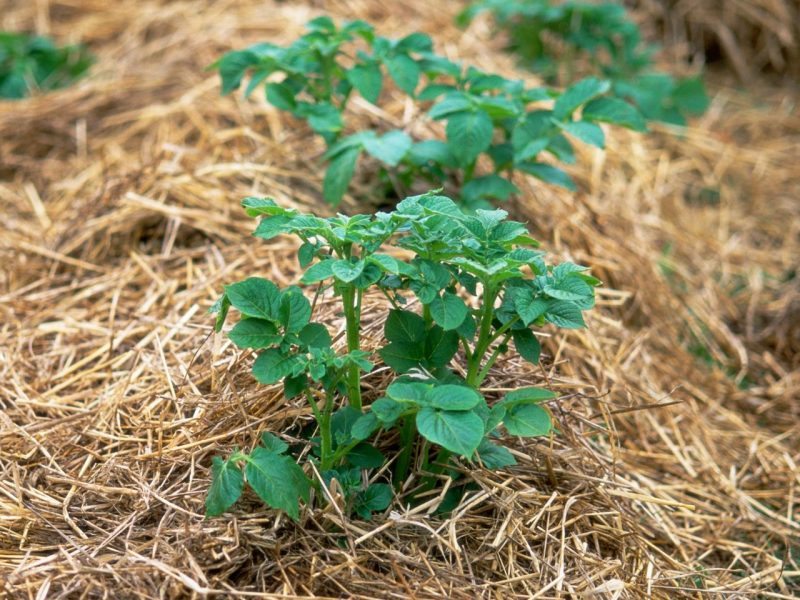
Dry soil before planting is abundantly shed with water. In dry summers, such a potato field will need additional watering.
The straw shelter needs to be replenished, since in the process of growing tubers they will need more space. The second reason is that the straw is caked, compacted, the layer is thinned, tubers can open to the sun. Additional fertilizing is not required, the plant will receive nutrition from decaying straw.
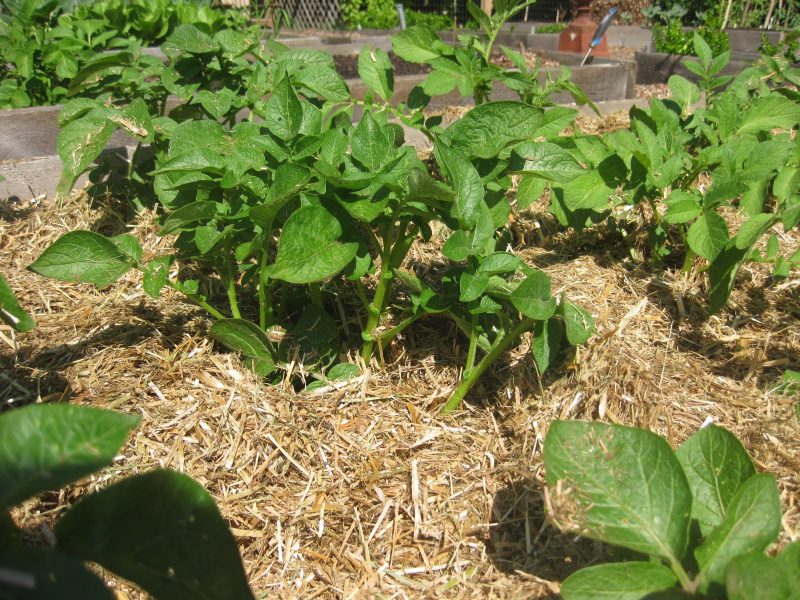
One bush of such potatoes gives up to 12 large tubers. All of them will be clean and healthy. You need to remove the potatoes with a fork, just picking up the straw.
A layer of straw makes it difficult to grow weeds, retains moisture, creates a good microclimate for the development of tubers, preventing them from overheating.
However, this method has its drawbacks. It is applicable in a small garden. In a large field, labor will be too great, and a lot of straw will be needed. Another nuisance is that mouse voles like straw. Here they can build their nests and destroy young tubers.
The technology of growing potatoes in bags
Potatoes are planted in ordinary or special bags with valves for the removal of tubers. This method is used with a lack of footprint. Bags are placed along paths or on the sunny side of buildings. For stability, they are dug into the ground.
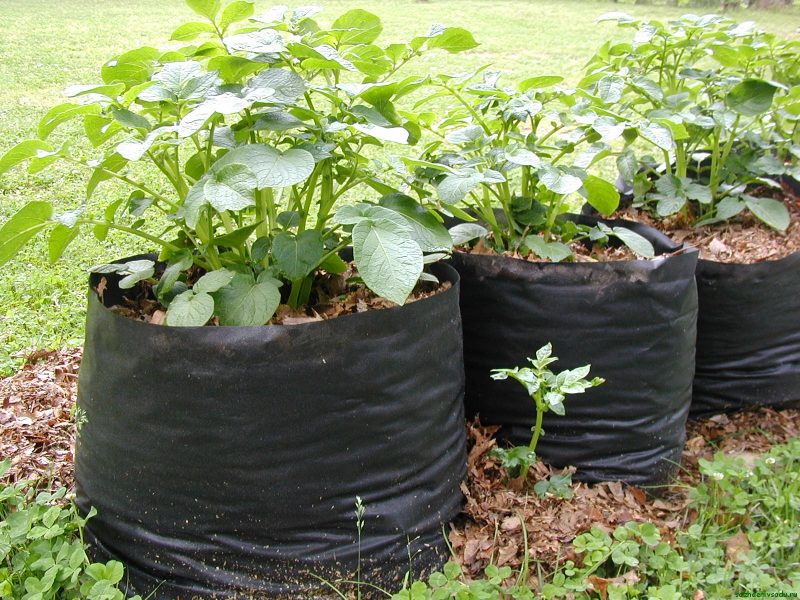
Start landing with the establishment of warm weather (end of April - beginning of May). The basis of success is properly prepared soil in the bag. It should be nutrient soil containing humus. It is laid up to 30 cm thick, planting material with eyes is laid out on top. They fall asleep with light soil of 15 cm.
Shoots will appear in 10-12 days. At a height of 15 cm, they are sprinkled with earth, i.e. spud, leaving only the tops. This technique is repeated 3-4 times. This stimulates the formation of roots and stolons, on which several layers of tubers appear.
The depth of the bag is not made more than a meter, otherwise the plant will not have enough moisture, which prevents the formation of new tubers. This method requires abundant watering. The walls of the bags warm up quickly, which contributes to the evaporation of moisture.
How to grow potatoes in boxes
To do this, use wooden boxes filled with earth. As potato tops grow, it is sprinkled with soil. Next, install the next box, and the bush grows already in it. The method makes it possible to develop stolons on which tubers are formed. The longer the stolons, the more tubers will form.

The method has both disadvantages and advantages.
Positive sides:
- Saving landing space.
- High yield.
- Ecological purity of culture.
- There is no need for hilling and weeding.
- Easy to harvest, just remove the boxes.
- The Colorado potato beetle does not attack, since the potatoes are covered with earth.
Of the disadvantages it should be noted:
- Physical and material costs of boxes.
- Preparation of nutrient soil to fill them.
- The need to monitor the humidity of the soil, to prevent excess moisture.
In general, this method has a right to exist and it has many adherents.
Growing potatoes from seeds
This is not the best way to get a potato crop, but in the case when there is not enough seed, the right solution. The seeds are small, quickly lose their ability to germinate. The next year after harvesting, they will give no more than 50% germination.

Sowing is done in hotbeds or nurseries. Small seeds on moist soil easily slam without deepening. After emergence, thin out, leaving a distance of 10 cm between them.
Seeds germinate after 10 days, plant seedlings at the age of two months, usually this occurs in mid-May. From such calculations, we determine the time of sowing seeds - the first of March.
After the establishment of persistent heat, usually on May 15-16, seedlings are planted on beds. Further care is carried out in the usual way - hilling, watering, feeding.
Chinese way
The objective of this method is to obtain the largest yield in a smaller area. Chinese agronomists use the ability of potatoes to form underground shoots - stolons. Additional tubers appear on them, productivity increases.

Potatoes are planted in a pit, as the shoots grow, they are completely sprinkled with a nutrient mixture. This is done several times until the pit is completely filled.
The method has several advantages:
- A small plot is enough for landing.
- Not a large amount of planting material is required.
- Weeding is eliminated.
- Watering is reduced.
- Bushes are protected from pests.
But the method is not so ideal. When using it, Russian vegetable growers got a slightly higher yield than usual. In addition, it is a laborious method to dig a hole, about a meter deep, you need to make maximum effort. Perhaps the Chinese have special varieties of potatoes. But most likely, the usual saving of land affects this.
According to Dutch technology
The method requires a spacious plot. From 6 to 8 tubers are planted per square meter. In each hole, 8 cm deep, sprouted tuber is sprouted up. Holes are arranged in rows, between which they leave a distance of 75 cm, between bushes in a row - 35 cm.

Each tuber is sprinkled on top with humus or rotted manure, ash and superphosphate are added. When seedlings appear, they are sprinkled to a height of 10 cm. If there is a threat of frost, you can completely sprinkle the shoots with earth, and then scrub it.
Two weeks after the emergence of seedlings, they are spudded to the height of the ridge up to 25 cm. The earth is buried from the aisles. With a wide landing, this is easy to do. Weed the soil thoroughly, preventing weeds from growing.
In wide aisles on high ridges, tubers are well warmed up by the sun, form a powerful root system. There is enough moisture in the ridges and in a drought it persists until watering or rain. Rainy weather is not terrible, excess moisture flows into deep furrows and does not flood the plant.
The powerful spreading bushes obtained during such planting yield a crop one and a half times higher than during a conventional planting.
Dutch farmers use mineral fertilizers and herbicides. In your garden plots, try using organic and mineral fertilizers. Use herbicides in minimal amounts, use biological plant protection products.
Mitlider and Gulich Method
It is also called the narrow bed method. Potato bushes do not tolerate competition. For full development, they need a lot of living space.
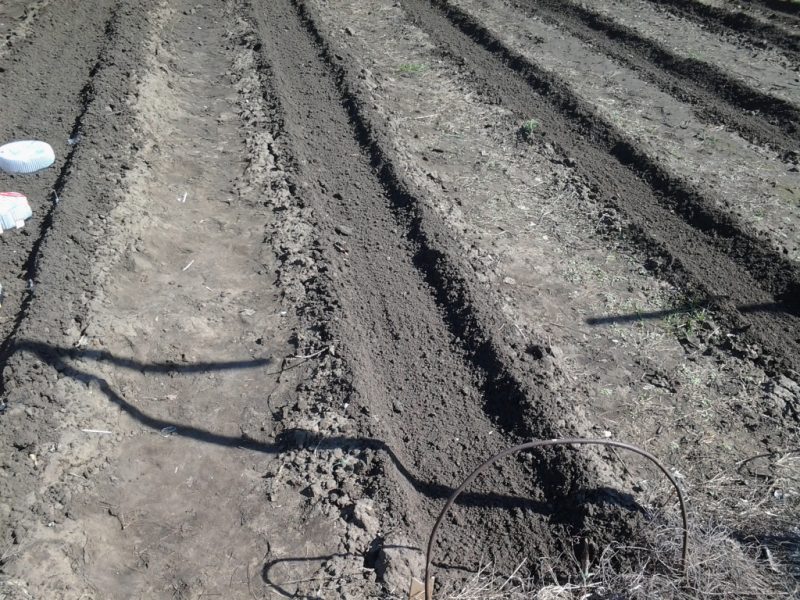
According to Mittlider, the width of the ridge is 45 cm. Two rows of potatoes are planted 30 cm across it. 30 cm are left in each row between the tubers, and they are planted in a checkerboard pattern. Between the beds make a meter-wide passage. The bed is fertilized and weeded, watered. In the aisle, the grass is gradually trampled down and does not grow.
Dr. Mitlider spends his work in California, where there is no frost. He does not plant tubers deeply and does not sprout seedlings. In Russian gardens, early spring potatoes are covered with frost from the film.
All other work on the care of the plant, as usual, for potatoes. On narrow beds, the plant receives a lot of light and oxygen, quickly ripens. After harvesting potatoes, the soil is inoculated with fast-growing greens.
With this method of cultivation, it is important to observe crop rotation so as not to accumulate weeds and pests in the soil.
Technology "under the film"
This method is used to produce early potatoes. Successful cultivation requires certain early varieties - Ariel, Caprice, Izora, Timo. Large potatoes are used for planting, they sprout faster and are more stable.
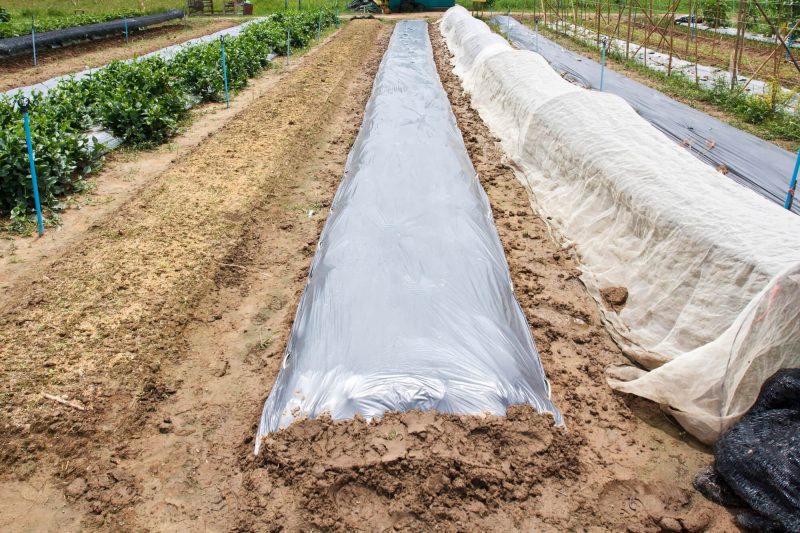
The size of the beds is chosen independently.
Usually apply landing schemes:
- 60x25-35.
- 70x25-30.
Shelter can be applied with a film according to the installed frame, it is possible to lay the film directly on the soil. The ground must be warm before planting. Sprouted tubers are planted.
When seedlings and warm weather appear, the bed is aired. When the weather gets hot, they make holes in the film or open the ends of the shelter for the day. With constant warm weather for a day, the film can be removed, and in the absence of night frosts it can be removed.
How to grow potatoes in greenhouses
To obtain young potatoes throughout the year, greenhouses are used to grow it.In heated greenhouses, tubers are planted in September to get a crop for the New Year holidays. In February and March, they land for young vegetables in May.
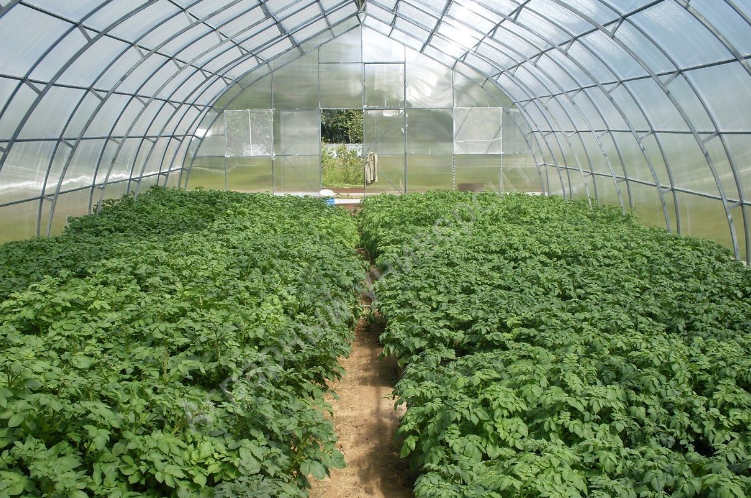
December and January are not suitable dates for planting, with a low daylight the potatoes grow poorly, and artificial lighting is not always justified. In summer, open ground is more appropriate for this.
Before planting, the tubers are vernalized (germinated) for up to 40 days. This is done so that its development in the greenhouse is minimal. It is good to expose it to sunlight, green tubers are unpleasant for pests.
Planting material is treated with a solution of a biological product of Baikal and Boverin. A very powerful cure for all pests is Prestige. But it is toxic.
In the greenhouse, you can arrange double beds - between plants 30 cm, between rows - 30 cm, between rows - 80 cm. The bushes are arranged with a shift from adjacent lines.
Top dressing is done along with watering. This can be an infusion of nettle, mullein and mineral fertilizers. Watered up to three times during development.
The temperature in the greenhouse should not be lower than 20 ° С, with the formation of flowers 23 ° С. Bushes spud or mulch. After the early harvest, free land is sown with fast-growing vegetables.
Whatever way potatoes are grown, the main goal is to get a high yield. Each of the presented methods has its followers. It is only necessary to carefully study the conditions of application of a particular method and clearly implement them.












